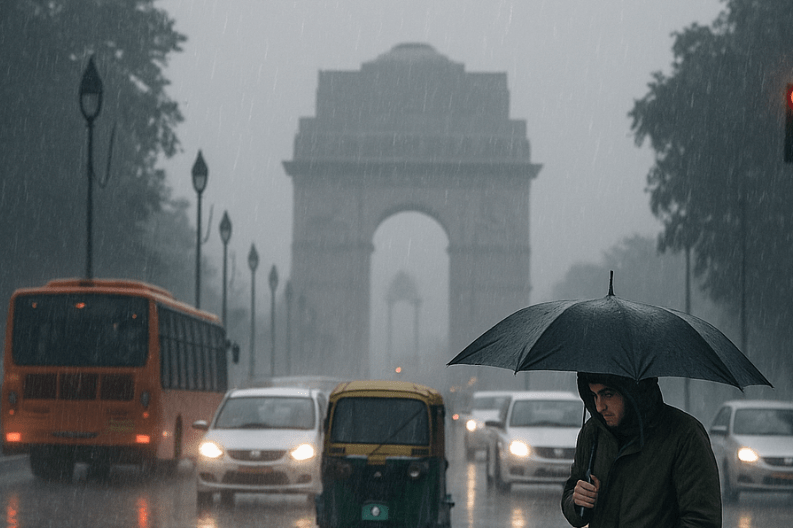Delhi faces heavy rainfall and chilly weather as residents woke up to unexpected showers on Wednesday morning. The rain brought a pleasant cool breeze, but it also caused delays in air travel and traffic congestion across the city. According to the India Meteorological Department (IMD), this sudden rainfall was triggered by an active western disturbance that led to lower temperatures and an extended spell of rain, which is rare for October.
This year, Delhi has seen unusual rainfall patterns. In October 2025, the city recorded 80.5mm of rain, more than five times the usual average of 15.1mm. In contrast, there was no rain at all in October 2024. Experts believe this sharp variation highlights shifting climate trends in northern India.
The showers started between 2 am and 5 am as light drizzles, followed by heavy rain in the afternoon from 2:30 pm to 5:30 pm. Several parts of the city received varying rainfall:
- Safdarjung: 12.6mm, later another 5.8mm
- Palam: 41.6mm
- Lodhi Road: 5.8mm
- Ridge: 37mm
- Ayanagar: 5.1mm
- Pusa: 22.5mm
- Mayur Vihar: 20mm
While the rain brought relief from pollution, it also disrupted air travel. Around 100 flights were delayed, and 15 flights were diverted to other cities due to low visibility. Of these, 8 flights were sent to Jaipur, 5 to Lucknow, and 2 to Chandigarh. The visibility at Palam Airport dropped sharply from 6,000 meters to just 1,200 meters. The IMD explained that a low-pressure area over north Rajasthan and Haryana, combined with an upper air cyclonic circulation, caused the widespread rainfall across the National Capital Region (NCR).
Despite the disruptions, many residents welcomed the drop in temperature. The cool breeze gave a hint of early winter, providing relief from the usual October heat. The IMD expects temperatures to dip even further in the coming days as the western disturbance gradually weakens.
Interestingly, this rainfall had a positive effect on Delhi’s air quality. The city’s average Air Quality Index (AQI) dropped to 164, the cleanest in seven years. Delhi also recorded 75 days of satisfactory air quality this year, a remarkable improvement in a city often known for pollution. Experts say that consistent rainfall since May has helped clean the air and settle dust particles.
Delhi’s rainfall pattern in 2025 has been far from ordinary. The city saw 186.4mm of rain in May, marking its wettest May on record. In August, it received 400.1mm of rainfall, the highest in 15 years. Meteorologists believe that changing wind patterns and the frequent occurrence of western disturbances are behind this shift.
Nearby regions also faced the effects of Delhi’s rain. In Chandigarh, two flights were diverted because of the heavy showers in Delhi, showing how weather disruptions in the capital can impact travel across northern India. Meanwhile, residents in Gurugram, Noida, and Ghaziabad also reported waterlogging and slower traffic due to the continuous rain.
Experts believe this wet October could signal broader changes in India’s monsoon behavior. Climate researchers have noted that western disturbances, which traditionally occur in winter, are now appearing more frequently in early autumn. This could lead to unpredictable rain patterns in the coming years.
As the rain subsides, the IMD forecasts that the weather will clear up by late Wednesday night. Minimum temperatures are likely to drop further, bringing early winter conditions to Delhi and the NCR.
Delhi faces heavy rainfall and chilly weather event has brought both comfort and challenges, improving air quality and cooling the city, but also highlighting the need for better preparedness for sudden climate shifts.



